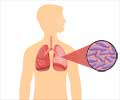An old antibiotic named Rifapentine has been found to be effective against the most common and contagious form of TB when given in high-doses.
An old antibiotic named Rifapentine has been found to be effective against the most common and contagious form of TB when given in high-doses.
Rifapentine, an approved drug for human use lost its market because when given in low doses it was a weak treatment for TB. In fact its makers stopped commercial production years ago, owing to its low demand.Now however, studies involving its use on mice have found it to be very promising as an initial treatment for active TB when administered in high doses.
Clinical trials are scheduled to begin next year in at least eight countries
The studies were carried out by Johns Hopkins infectious disease specialist Eric Nuermberger, M.D., an assistant professor at The Johns Hopkins University School of Medicine who headed the team of researchers from Hopkins and elsewhere.
The studies on mice revealed that giving higher and daily doses of rifapentine in place of another antibiotic, rifampin, cured mice two to three times faster than the much older, standard regimen of drugs including rifampin.
The researchers claimed that the average time to clear the potentially fatal bacterial infection could be reduced from six months to three or less, if tests in people confirm the findings in mice.
Advertisement
The experts said that another 424,000 are infected with the more dangerous, multidrug-resistant form of the disease.
Advertisement
Rifapentine, approved by the U.S. Food and Drug Administration in 1998 for treating widespread, drug-susceptible TB, was initially developed as a less cumbersome, once-weekly tablet.
But the drug “was never really considered effective in low doses when compared to the gold standard, daily, high-dose regimens with rifampin,” said Nuermberger.
Rifampin (sold as Rifadin and Rimactane) was F.D.A. approved in 1968.
This possible shortened time for the treatment comes through a progress made by the team’s top scientist, Richard Chaisson, M.D., director of Hopkins’ Center for TB Research, in October.
It was demonstrated that moxifloxacin (Avelox), another antibiotic, when substituted for ethambutol (Myambutol), may reduce treatment times from six months to four.
The researchers investigated the high-dose potential of rifapentine because the drug was in the same class of drugs as rifampin.
Rifampin is a part of the standard antibiotic cocktail of rifampin, pyrazinamide, and isoniazid, a triple drug combo sold as Rifater, or with moxifloxacin in place of isoniazid.
It is given as a part of Directly Observed Therapy Short-Course (DOTS) as the drugs are usually given in presence of a caregiver to ensure compliance; the regimen requires several daily doses for six to nine months.
However, DOTS cures 95 percent of those treated, but the lengthy treatment period has proved to be a problem for patients, who sometimes miss taking their drugs on time, minimizing the therapy’s effectiveness.
In the new study, Nuermberger and his team tested seven different combinations of antibiotic drugs in hundreds of mice infected with active TB.
Some of them were treated with the standard DOTS regimen, daily Rifater, while others took rifapentine in place of rifampin. Rifapentine, in daily amounts similar to what an adult human would take (600 milligrams), was also tested separately in combination with moxifloxacin- or isoniazid-based DOTS regimens.
Over a six month period, blood and tissue testing were done in order to see how quickly each drug combination removed active TB form the body. Treated mice were also tested three months later to check against any potential for relapse.
After 10 weeks of drug therapy, mice taking rifapentine and moxifloxacin tested negative for active TB and remained so when retested three months later.
Those treated with rifapentine and isoniazid also tested clear of the bacterium by 10 weeks, but were at least 10 percent more likely to relapse unless treatment persisted for another month.
In the meantime, the traditional DOTS regimen mostly took the full six months to work.
According to the results, a distinct advantage in using rifapentine over rifampin, with rifapentine having remained in the blood in three times higher concentrations throughout treatment, indicating the drug’s “longer-lasting action,” said Nuermberger.
Two clinical trials are scheduled to study high-dose and daily combinations with rifapentine.
The study will be published in the Public Library of Science journal PLoS Medicine online.
Source-ANI
LIN/P










